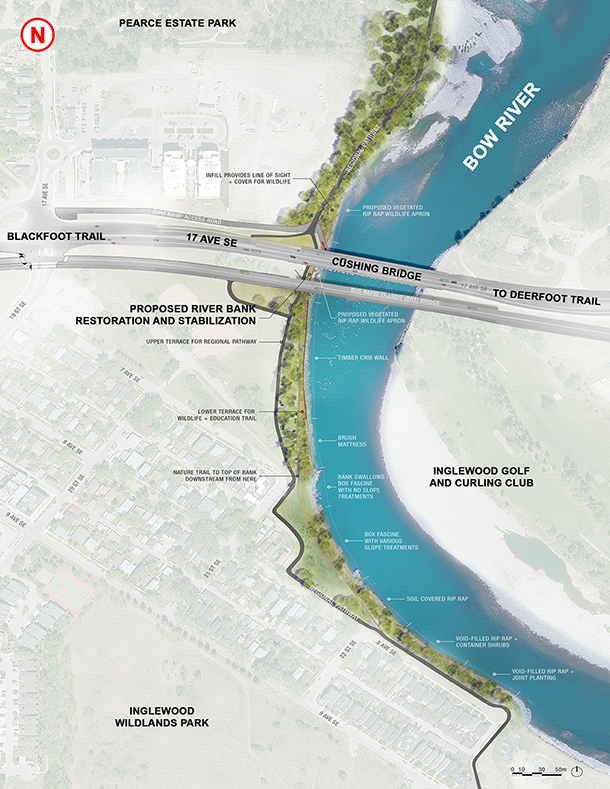Bioengineering Demonstration and Education Project: Technical Project Details
The Bioengineering Demonstration and Education Project is located between Pearce Estate Park and the Inglewood Bird Sanctuary on the Bow River in the community of Inglewood.
The site was initially identified by The Government of Alberta (GOA) as a candidate site for a bioengineering demonstration and education project under the department’s Fisheries Habitat Enhancement and Sustainability (FISHES) program.
The area was unique in southern Alberta as it was heavily eroded during the 2013 flood, had extremely unstable slopes, and prior classical “hard” engineering treatments installed immediately following the flood (rock groynes and rip rap bank protection) and could be used for comparison to the proposed bioengineering treatments.
These physical elements provided an excellent opportunity to apply a variety of bioengineering treatments to address riparian health, slope stability, bank erosion, and fisheries habitat issues which varied significantly from site to site across the project area.
Early in the planning stages, it was recognized that the project aligned with and complemented a wide variety of The City of Calgary and Government of Alberta policies and programs. The project achieves key outcomes and speicifc actions under the City’s Riparian Strategy and Riparian Action Program and the Government of Alberta’s FISHES Program and the Watershed Resiliency and Restoration Program’s Strategic Plan.
Project design
Design consultants, Kerr Wood Leidal Associates Ltd. and Hemmera Envirochem Inc., were engaged by GOA prepare bioengineering designs for each of the separate sites within the project area, with an aim to demonstrate a diverse and broad variety of bioengineering treatments in different environmental (i.e. moisture, soil and slope conditions). The scope of work also included preparation of an education plan and a long-term. 10 year monitoring plan for the project.
The designers worked closely with a number of geophysical, bioengineering, landscape and environmental education sub-consultants and local groups including, Thurber Engineering Ltd., Terra Erosion Control Ltd., Polster Environmental Services Ltd., O2 Planning and Design Inc., River Watch and Bow Habitat Station to create a final plan for the project.
HEMMERA DESIGN REPORT (4. Proposed Design, Page 4-1 – 31/142)"The designs are based on providing rock armor extending to the vegetation trim line to protect against scour, bank erosion and ice abrasion, and various bioengineering treatments to the top of bank to provide bank protection and improve riparian, aquatic and terrestrial habitats while also improving aesthetics. Several bioengineering treatments have been included in the design to showcase a diversity of techniques applicable to each site. Human and wildlife passage are factored into the design and have highly influenced the final layout“
The Bioengineering Demonstration and Education Project uses a variety of bioengineering techniques (such as brush mattress and fascines) along with other fish habitat enhancements (such as boulder clusters) to stabilize steep slopes along the west bank, create habitat and enhance visual aesthetics.
The existing topography, river hydraulics, geomorphology, habitats and erosion protection influenced the design of each sub-site, where different bioengineering techniques were selected to address these conditions and to showcase a range of treatments.
About the project
This project offers a unique opportunity to urban planners, environmental consultants and engineers to scientifically evaluate soil bioengineering techniques and their use in riparian restoration projects.
Questions?
Do you have questions about the project, monitoring results or bioengineering?
Contact 311 or fill out a form.
Key design features of each site
Site One
Approximately 370m in length, located along the west bank of the Bow River extending approximately 280m upstream of the Cushing Bridge on 17th Ave. to the first rock groyne (upstream groyne).
Pre-Construction Conditions: While the bank did not retreat during the 2013 flood, larger trees were uprooted exposing the existing concrete rubble riprap beneath.
Design features:
- Vegetated wildlife corridor and regional pathway
- Vegetated riprap with rooted live cuttings
- Vegetated timber crib wall
- Fish habitat rock spurs
- Fish habitat boulder clusters
- Vegetated soil wrap
- Brush Mattress with rock toe
- Brush layer with contour fascline
Site Two
Approximately 120m in length, located on the river-right bank of the Bow River. The site abuts and starts immediately downstream of Site 1 and is bounded by the two existing rock groyne structures installed prior to the Bioengineering Demonstration and Education Project.
Pre-Construction Conditions: Bank receded 17m during the 2013 flood (KWL, 2016)
Design features:
- Box Fascine
- Slope treatment A: Brush Mattress with Contour Fascine
- Slope treatment B: Hedge Brush Layers
- Slope treatment C: Live Staking
Site Four
Extends from the downstream groyne of Site 2, a distance of approximately 360m on the river-right bank of the Bow River. The site includes the pre-existing rip rap bank protection, installed immediately following the 2013 flood, which ends near the Inglewood Bird Sanctuary. Site 4 is immediately adjacent to 8 Avenue S.E.
Pre-Construction Conditions: Consisted of existing riprap bank protection with vegetated upper bank slope, above the 5-year flood level.
Design features:
- Vegetated rip rap method A: Soil covered riprap with container shrub plantings
- Vegetated rip rap method B: Void filled riprap using top soil and plug plantings
- Vegetated rip rap method C: Void filled riprap using pitrun and live cutting plantings
Putting down roots
Riparian restoration designs should incorporate the use of native species that are adapted to the environmental characteristics of the restoration site and to the desired end land use.
Specific plant species were chosen based upon “Classification and Management of Riparian and Wetland Sites of Alberta’s Prairie Biome” (Thompson and Hansen, 2002) and an approved planting list provided by The City of Calgary.
Native woody vegetation with adventitious roots, like willows and poplar, are best suited for bioengineering projects. Examples of live cuttings used in the Bioengineering Demonstration, and Education Project include:
- Yellow Willow (Salix lutea)
- Sandbar Willow (Salix exlgua)
- Balsam Poplar (Populus balsamifera)
- Red Osier Dogwood (Cornus stolonifera)
What is a cutting?
A cutting is a portion of a branch or stem harvested from a parent plant for the production of a new independent plant that will form shoots and roots under the right environmental conditions.
Cuttings are the main live vegetation material used in bioengineering construction. When plant roots and branches grow along the river’s edge they weave together forming a sturdy network that helps hold soil in place and provides natural habitat for fish and wildlife.
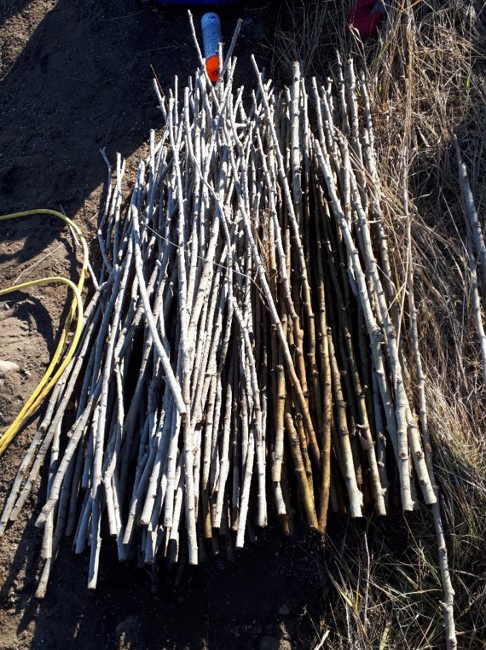
Photo of willow stakes used on site.
The table below describes the bioengineering techniques used on-site.
| Technique | Use | Example |
|---|---|---|
| Vegetated Riprap with Rooted Live Cuttings: Rooted live cuttings are carefully planted into joints or open spaces between existing or placed riprap. Special backfilling and soil amendments are needed to protect and support the delicate root mass. |
|
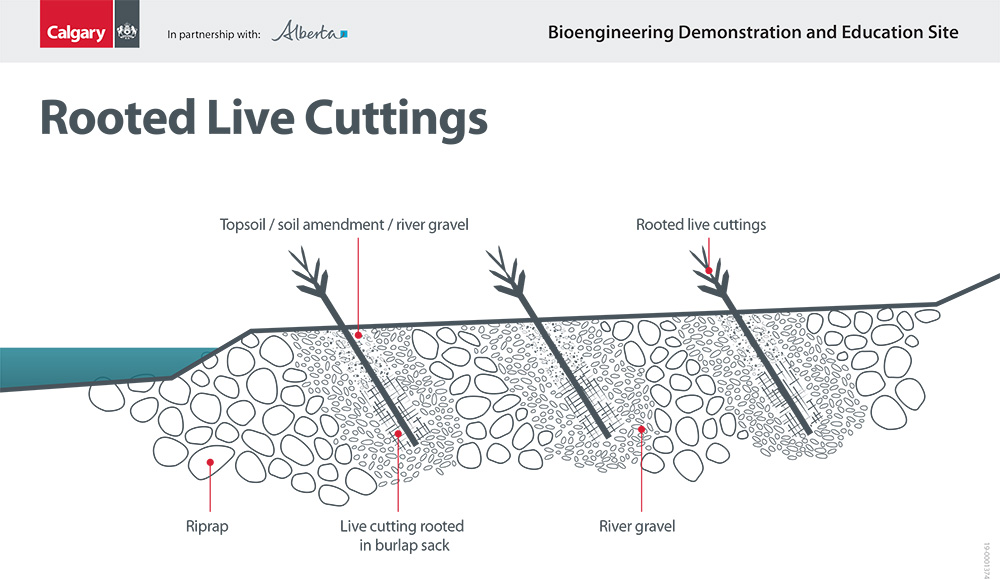 |
| Timber Crib Wall: A structure made of interlocking logs with live vegetation placed between the seams of each layer. |
|
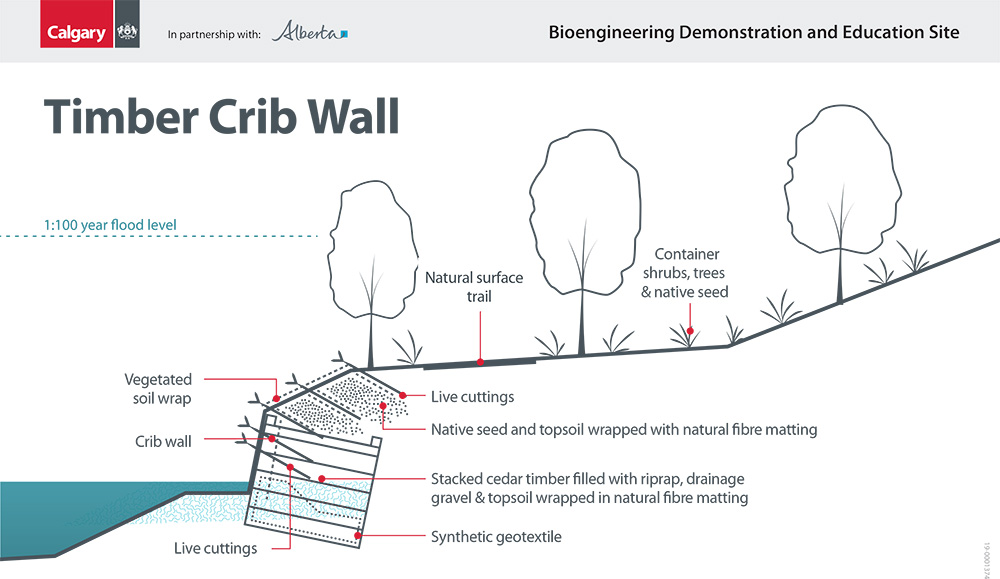 |
| Timber Crib Wall with Fish Shelters: Submerged fish habitat niches are created by placing the crib wall on concrete blocks and large rocks. |
|
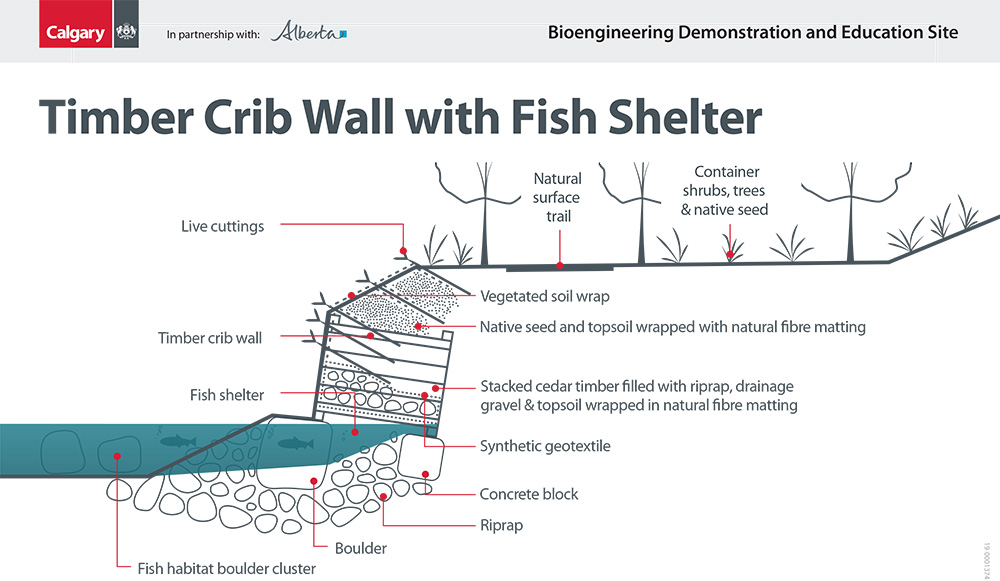 |
| Vegetated Soil Wrap: Multiple layers of planting material wrapped in a biodegradable geotextile separated by rows of live cuttings. |
|
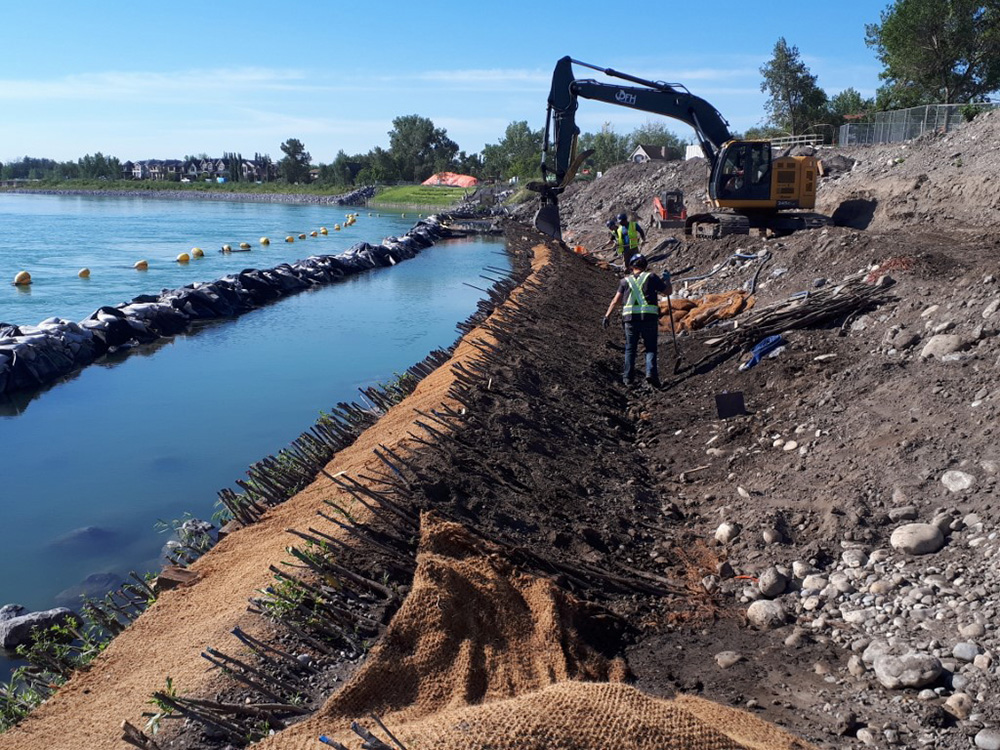 |
| Brush Mattress: A layer of interlaced live cuttings placed like a flat mattress on the riverbank. |
|
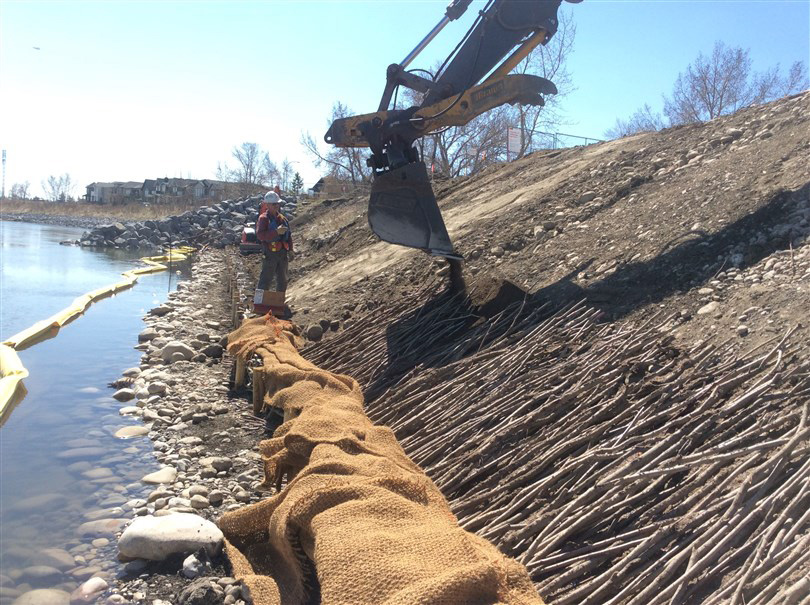 |
| Box Fascines: Horizontal bundles of live plant material placed at the bottom of an eroding bank often secured in place withwooden poles and wire. |
|
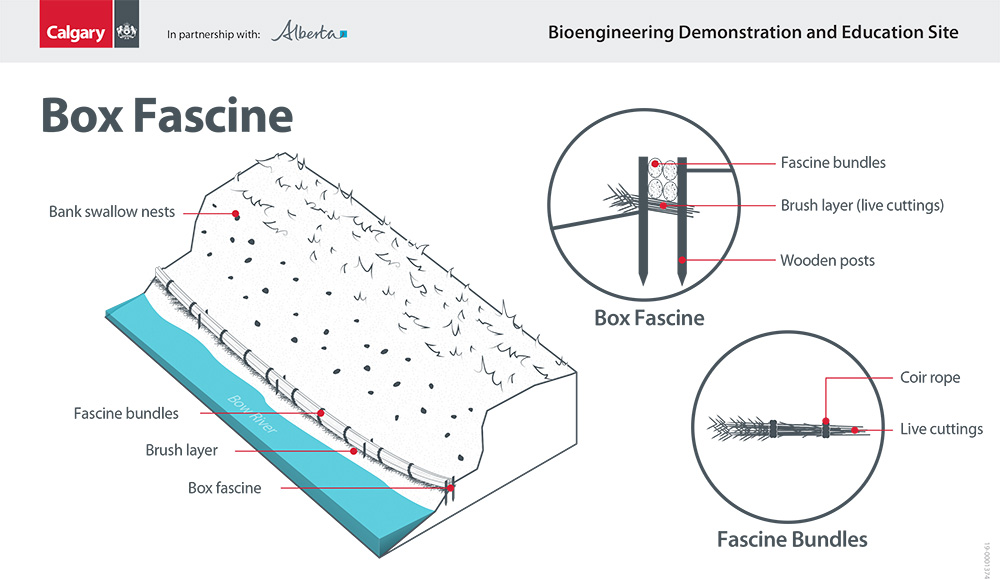 |
| Brush Mattress with Contour Fascine: A layer of interlaced live cuttings placed like a flat mattress at the toe of the riverbank followed by rows of cylindrical bundles on contour and equally spaced up to the top of the slope. |
|
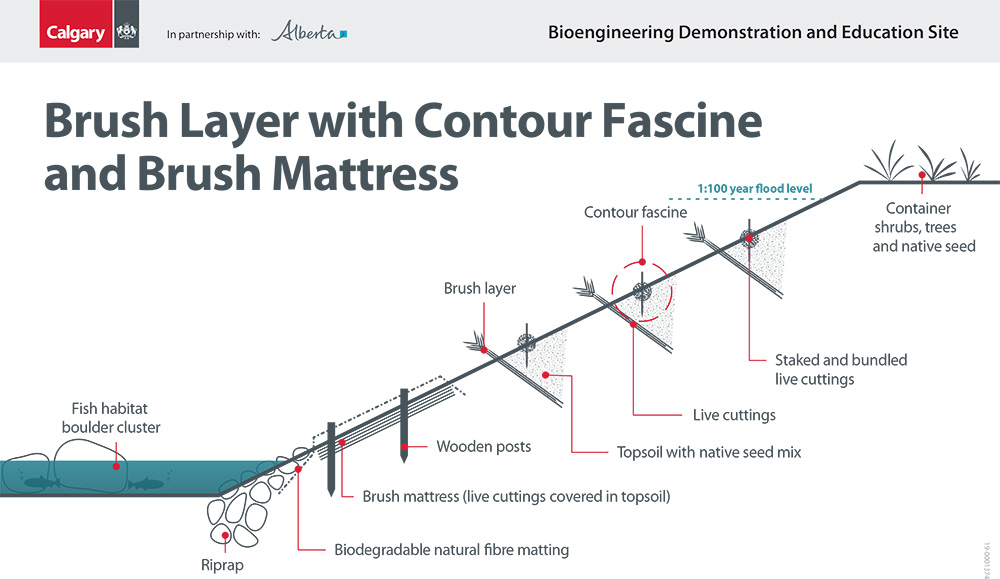 |
| Hedge Brush Layers: Several horizontal rows of live cuttings interspersed with native shrubs. Plants are driven in perpendicular to the slope or placed horizontally into a trench and backfilled. |
|
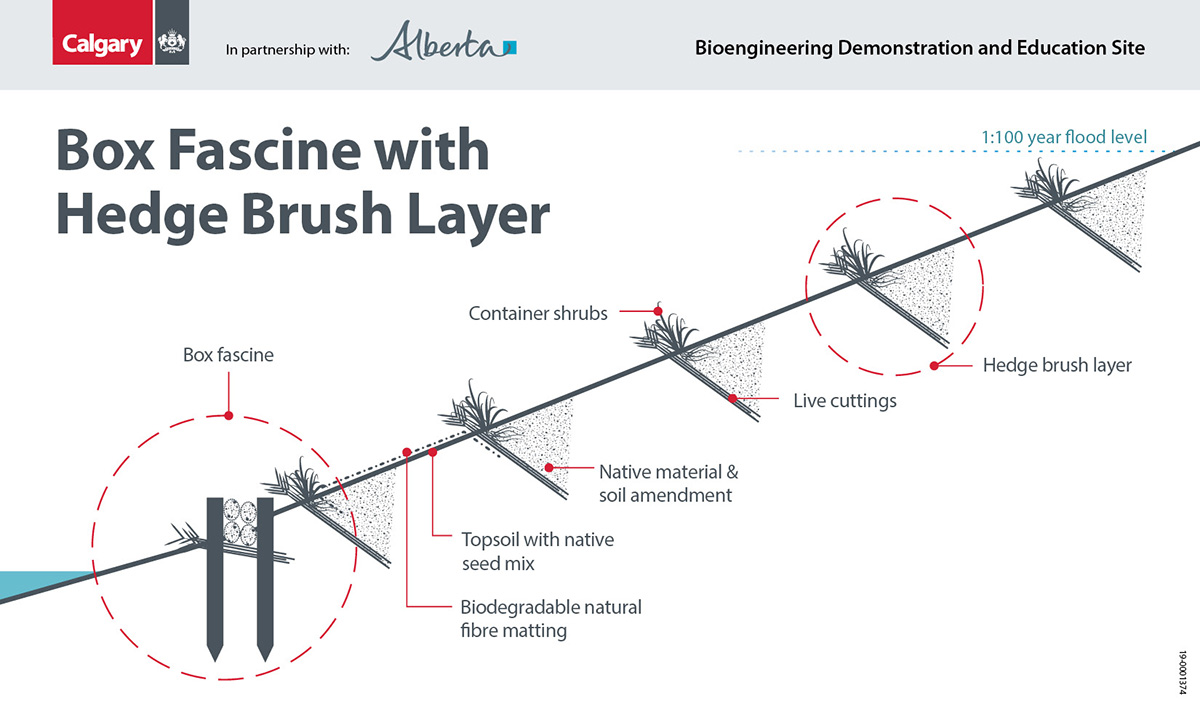 |
| Live Staking: Single live cuttings inserted into the ground like stakes and spaced between 20cm to 1m apart |
|
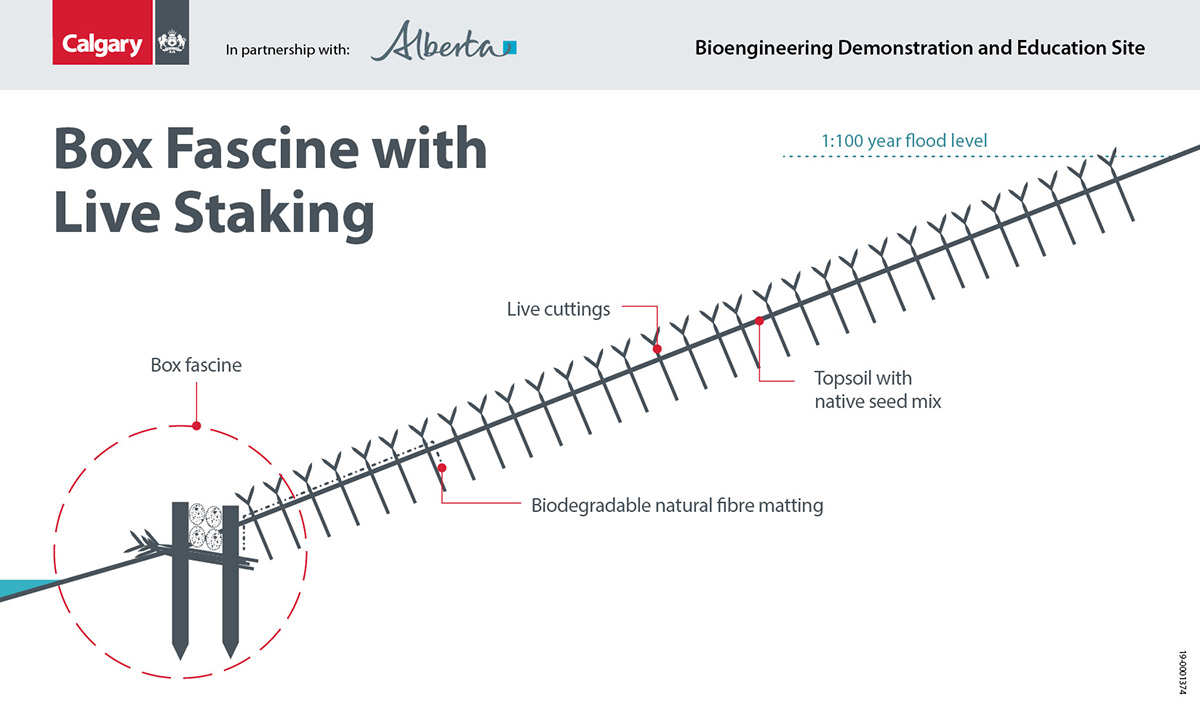 |
Vegetated RipRap Techniques:
|
|
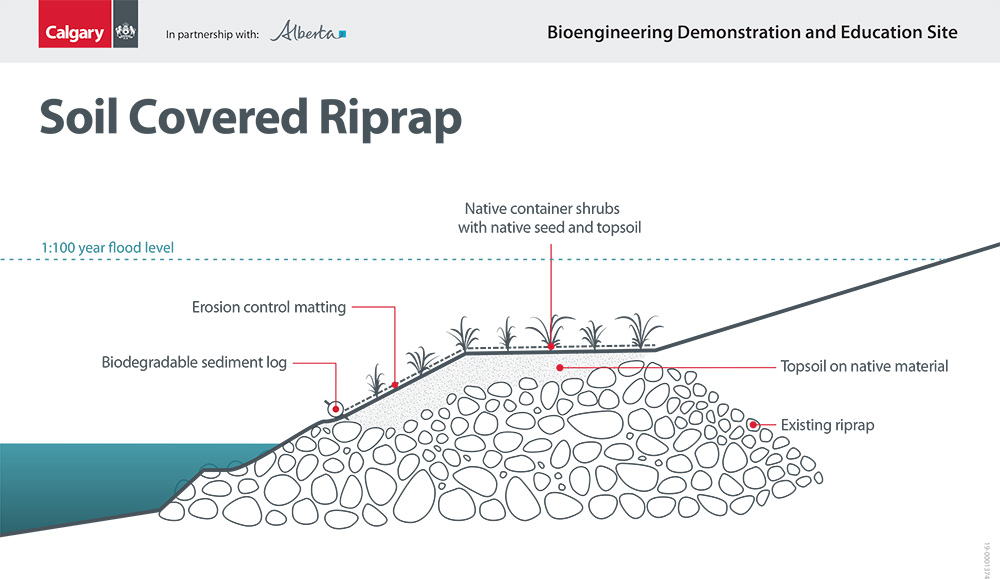 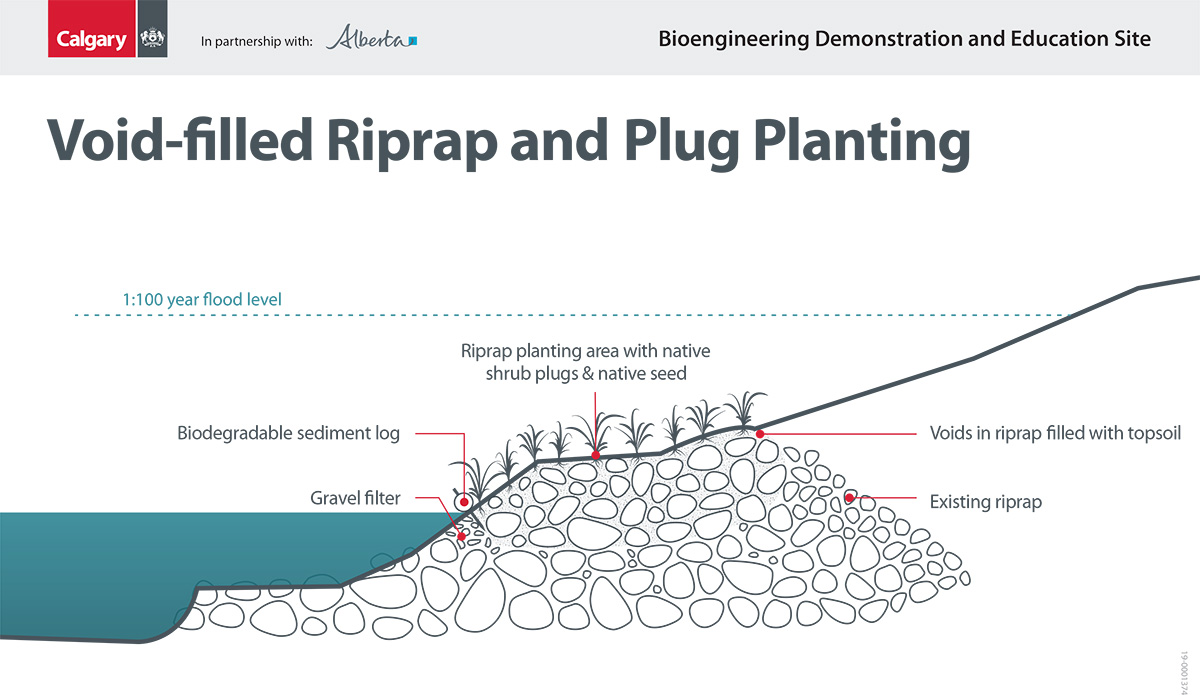 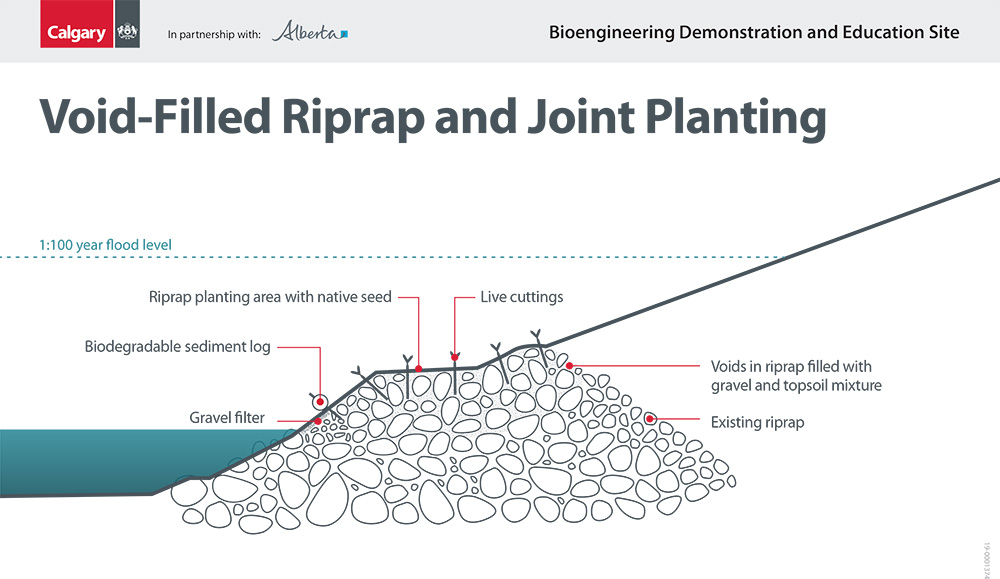 |
Please note: A soil amendment was placed on all soils used in the project - particularily the soils in immediate contact with live cuttings. The application of soil amendments within bioengineering techniques will address deficiencies in soil chemistry (e.g. soil salinity, available nitrogen, phosphorous, potassium, pH, soil toxins) and will enhance soil moisture retaining capacity.
The table below describes the fish and wildlife habitat strategies used on site:
| Technique | Use |
|---|---|
Fish Habitat Structures:
|
|
Wildlife Corridor:
|
|
Bank Swallow Nests:
|
The table below describes the “hard” engineering techniques existing on site.
| Technique | Use |
|---|---|
Riprap:
|
|
Riprap Groyne:
|
|
Project resources
- Site Assessment Report: Summarizes background knowledge and initial site assessments made by Hemmera’s Integrated Project Team
- Final Design Report: Provides a summary of the analysis and final design of the works associated with bank protection, fish habitat enhancement and riparian restoration of the Bow River.
- Construction Drawings
Planning Resources
For more information on planning Riparian Restoration projects in Alberta, or determining priorities for fish habitat restoration projects, the following may be useful:
- Design Guidelines for Erosion and Flood Control Projects for Streambank and Riparian Stability Restoration. Project No. CW2098. Prepared for the City of Calgary by AMEC Environment and Infrastructure. Calgary. February 2012.
- Stepping Back from the Water: A Beneficial Management Practices Guide for New Development Near Water Bodies in Alberta’s Settled Region. Government of Alberta. 2012 ISBN: 978-1-4601-0058-5
- Riparian Areas: A User’s Guide to Health. Alberta Riparian Habitat Management Society (Cows and Fish).
- Planning Your Riparian Planting Project in Alberta. A fact sheet produced by Growing Forward 2, Government of Alberta, and Government of Canada
- Hale, G., N. Ambrose, A. Bogen, K. Spicer-Rawe, M. Uchikura and E. Saunders. 2005. A Field Guide to Common Riparian Plants of Alberta. Cows and Fish Program. 63 pages. ISBN: 0-7785-4067-7
- Southern Alberta Fisheries Habitat Enhancement and Sustainability Program. 2015. A Guide to Understanding and Using the Project Selection and Priority Ranking Tool. Alberta Environment and Parks, Calgary. 23 pp.
- Southern Alberta Fisheries Habitat Enhancement and Sustainability Program. 2019. FISHES. A User’s Guide to the Fisheries Habitat Enhancement and Sustainability Program’s Evaluation, Scoring and Ranking Model. Alberta Environment and Parks, Calgary.
- City of Calgary Plant Lists – Recommendations Based on Habitat Type and Desired Outcome to Inform Revegetation Work. City of Calgary, 2019.
- Growing Restoration – Natural Fixes to Fortify Streambanks. Alberta Riparian Habitat Management Society (Cows and Fish.)
- Manual for Riparian Forest Buffer Establishment in Alberta. Agroforestry and Woodlot Extension Society.
- Riparian Areas in Calgary


